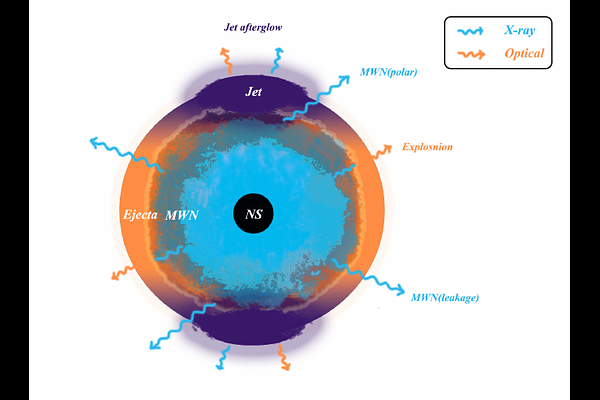EP241021a: A catastrophic collapse/merger of compact star binary leading to the formation of a remnant millisecond magnetar?

EP241021a: A catastrophic collapse/merger of compact star binary leading to the formation of a remnant millisecond magnetar?
Guang-Lei Wu, Yun-Wei Yu, Liang-Duan Liu, Zi-Gao Dai, Wei-Hua Lei, Xue-Feng Wu, Dong Xu, Bing Zhang, Jin-Ping Zhu, Yuan-Chuan Zou
AbstractObservations of fast X-ray transients (FXRTs) with the Einstein Probe have successfully led to the discovery of some unusual extragalactic optical transients. EP241021a is a newly discovered FXRT that was featured by a significant bump around ten days in both optical and X-ray bands. This timescale and the exceptionally high peak bolometric luminosity up to $\sim \rm 10^{44}erg~s^{-1}$ of the optical bump make it somewhat similar to fast blue optical transients, but still distinctive from them by its relatively red color. We then suggest that the multi-wavelength bump of EP241021a could represent an explosion-type transient, while the underlying power-law decaying component of the optical and X-ray emission as well as the total radio emission are produced by a moderately relativistic jet. By fitting the observed multi-wavelength light curves, it is found that the explosion ejecta that produce the thermal optical emission can have a mass of $\sim0.03~M_{\odot}$, an expanding velocity of $\sim0.25~c$, and an optical opacity of $\sim12~\rm cm^2g^{-1}$, which was continuously powered by a rapidly rotating and highly magnetized neutron star (NS; i.e., a magnetar). In addition to heating the explosion ejecta, the magnetar also provided the dominant contribution to the observed X-ray rebrightening through the non-thermal emission of its wind. These properties suggest that the explosion may result from a catastrophic collapse/merger of a compact star system, which led to the formation of a millisecond magnetar, and the possible progenitor could be an accreting white dwarf (WD) or a binary consisting of double WDs, double NSs, or a WD and an NS.